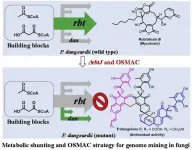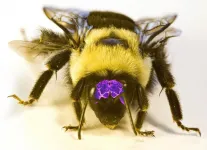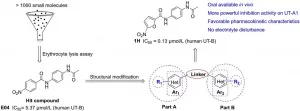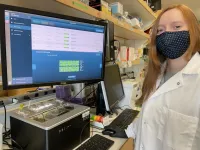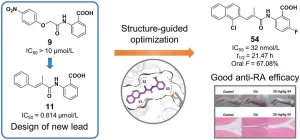Moffitt investigators identify STING gene methylation allows melanoma to evade the immune system
Findings lead to the development of therapeutic strategies to overcome it
2021-04-08
(Press-News.org) TAMPA, Fla. (April 8, 2021) -- A dysfunctional immune system significantly contributes to the development of cancer. Several therapeutic strategies to activate the immune system to target cancer cells have been approved to treat different types of cancer, including melanoma. However, some patients do not show beneficial clinical responses to these novel and very promising immunotherapies. In a new article published in Proceedings of the National Academy of Sciences of the United States of America, Moffitt Cancer Center researchers demonstrate how an important defect in STING gene expression in melanoma cells contributes to their evasion from immune cell detection and destruction.
Several different mechanisms have been discovered that allow cancer cells to avoid immune cell detection and destruction, including defective T cell function, losses in expression of key proteins on tumor cells and defective cell signaling in both immune and tumor cells. An important signaling pathway that contributes to interactions between tumor cells and immune cells is the interferon signaling pathway. The interferon pathway increases expression of molecules that allow tumor cells to be recognized and killed by immune cells. One of the key molecules in the interferon signaling pathway is STING, which is activated by the protein cGAS.
Moffitt researchers previously demonstrated that STING activity is commonly suppressed and altered in a subset of melanomas, which prevents the ability of these tumor cells to be targeted by the immune system. The research team wanted to further the understanding of the importance of alterations in STING signaling in melanoma and determine how STING expression becomes suppressed. They focused on a process called epigenetic modification during which methylation groups are added to the DNA regulatory regions of genes, resulting in genes being turned off.
The researchers performed a series of laboratory experiments and discovered that the DNA regulatory region of the STING gene is highly modified by methylation groups resulting in loss of STING gene expression in certain melanoma cell lines. Importantly, they confirmed these findings in patient clinical samples of early and late-stage melanomas and showed similar methylation events and loss of expression of the upstream STING regulator cGAS.
Next, the researchers demonstrated that it is possible to reactivate expression of STING and/or cGAS with a demethylating drug or genetic approaches that overcome methylation. These interventions successfully turned on STING functional activity, resulting in increased interferon levels when triggered by STING agonist drugs that enabled the melanoma cells to now be recognized by immune cells and targeted for destruction.
These findings demonstrate for the first time that a strategy to overcome STING gene methylation can restore interferon signaling and immune cell activity in melanoma and improve a cell-based immunotherapy when combined with STING agonist drugs.
"These studies show the critical importance of an intact STING pathway in melanomas for optimal T cell immunotherapy success, and how to overcome a notable STING defect in melanoma cases of gene hypermethylation by a combination therapy," said James J. Mulé, Ph.D., senior author and associate center director for Translational Science at Moffitt. "Unless patients' melanomas are pre-screened for intact versus defective STING, it is not at all surprising that clinical trials of STING agonists have, to date, uniformly failed."
INFORMATION:
Moffitt collaborated with Glen Barber, Ph.D., from the University of Miami for this study. It was funded by the National Cancer Institute (R01 CA148995, R01 CA184845, P30 CA076292 and P50 CA168536), the Cindy and Jon Gruden Fund, the Chris T. Sullivan Foundation, the V Foundation and the Dr. Miriam and Sheldon G. Adelson Medical Research Foundation.
About Moffitt Cancer Center
Moffitt is dedicated to one lifesaving mission: to contribute to the prevention and cure of cancer. The Tampa-based facility is one of only 51 National Cancer Institute-designated Comprehensive Cancer Centers, a distinction that recognizes Moffitt's scientific excellence, multidisciplinary research, and robust training and education. Moffitt is the No. 11 cancer hospital and has been nationally ranked by U.S. News & World Report since 1999. Moffitt's expert nursing staff is recognized by the American Nurses Credentialing Center with Magnet® status, its highest distinction. With more than 7,000 team members, Moffitt has an economic impact in the state of $2.4 billion. For more information, call 1-888-MOFFITT (1-888-663-3488), visit MOFFITT.org, and follow the momentum on Facebook, Twitter, Instagram and YouTube.
ELSE PRESS RELEASES FROM THIS DATE:
2021-04-08
Genome mining combined metabolic shunting and OSMAC strategy of an endophytic fungus leads to the production of diverse natural products
Endophytic fungi are promising producers of bioactive small molecules. Bioinformatic analysis of the genome of an endophytic fungus Penicillium dangeardii revealed 43 biosynthetic gene clusters, exhibited its strong ability to produce numbers of secondary metabolites. However, this strain mainly produce rubratoxins alone with high yield in varied culture conditions, suggested most gene clusters are silent. Efforts for mining the cryptic gene clusters in P. dangeardii, including epigenetic regulation and one-strain-many-compounds (OSMAC) approach were failed probably due to the high yield of rubratoxins. A metabolic ...
2021-04-08
A team of archaeologists in north-west the Kingdom of Saudi Arabia has uncovered the earliest evidence of dog domestication by the region's ancient inhabitants.
The discovery came from one of the projects in the large-scale archaeological surveys and excavations of the region commissioned by the Royal Commission for AlUla (RCU).
The researchers found the dog's bones in a burial site that is one of the earliest monumental tombs identified in the Arabian Peninsula, roughly contemporary with such tombs already dated further north in the Levant.
Evidence ...
2021-04-08
Indole, and structures derived from it, are a component of many natural substances, such as the amino acid tryptophan. A new catalytic reaction produces cyclopenta[b]indoles--frameworks made of three rings that are joined at the edges--very selectively and with the desired spatial structure. As a research team reports in the journal Angewandte Chemie, the rates of the different steps of the reaction play a critical role.
Indole derivates are widely distributed in nature; they are part of serotonin and melatonin, as well as many alkaloids--some of which are used as drugs, for example, as treatments for Parkinson's disease. Indole is an aromatic six-membered ring fused to a five-membered ring along one edge. The five-membered ring has a double bond and ...
2021-04-08
Using a surprisingly simple technique, researchers in the University of Arizona Department of Neuroscience have succeeded in approximating how many brain cells make up the brains of several species of bees, ants and wasps. The work revealed that certain species of bees have a higher density of brain cells than even some species of birds, whereas ants turned out to have fewer brain cells than originally expected.
Published in the scientific journal Proceedings of the Royal Society B, the study marks the first time the new cell counting method has been applied to invertebrate animals and provides a robust and reproducible protocol for other research groups studying the brains of ...
2021-04-08
Discovery of novel diarylamides as orally active diuretics targeting urea transporters
Urea transporters (UT) play a vital role in the mechanism of urine concentration and are recognized as novel targets for the development of salt-sparing diuretics. Thus, UT inhibitors are promising for development as novel diuretics. In this study the authors discovered a novel UT inhibitor with a diarylamide scaffold by high-throughput screening. Optimization of the inhibitor led to the identification of a promising preclinical candidate, N-[4-(acetylamino)phenyl]-5-nitrofuran-2-carboxamide ...
2021-04-08
The full assembly of human chromosome 8 is reported this week in Nature. While on the outside this chromosome looks typical, being neither short nor long or distinctive, its DNA content and arrangement are of interest in primate and human evolution, in several immune and developmental disorders, and in chromosome sequencing structure and function generally.
This linear assembly is a first for a human autosome - a chromosome not involved in sex determination. The entire sequence of chromosome 8 is 146,259,671 bases. The completed assembly fills in the gap of more than 3 million bases missing from the current reference genome.
The Nature paper is titled "The structure, function and evolution of a complete chromosome 8."
One of several intriguing characteristics ...
2021-04-08
Using DNA structures as scaffolds, Tim Liedl, a scientist of Ludwig-Maximilians-Universitaet (LMU) in Munich, has shown that precisely positioned gold nanoparticles can serve as efficient energy transmitters.
Since the inception of the field in 2006, laboratories around the world have been exploring the use of 'DNA origami' for the assembly of complex nanostructures. The method is based on DNA strands with defined sequences that interact via localized base pairing. "With the aid of short strands with appropriate sequences, we can connect specific regions of long DNA molecules together, rather like forming three-dimensional structures by folding a flat sheet of paper in certain ...
2021-04-08
It's like something out of science fiction. Research led by Bigelow Laboratory for Ocean Sciences has revealed that a group of microbes, which feed off chemical reactions triggered by radioactivity, have been at an evolutionary standstill for millions of years. The discovery could have significant implications for biotechnology applications and scientific understanding of microbial evolution.
"This discovery shows that we must be careful when making assumptions about the speed of evolution and how we interpret the tree of life," said Eric Becraft, the lead author on the paper. "It is possible that some organisms go into an evolutionary ...
2021-04-08
Design, synthesis, molecular modeling, and biological evaluation of acrylamide derivatives as potent inhibitors of human dihydroorotate dehydrogenase for the treatment of rheumatoid arthritis
Human dihydroorotate dehydrogenase (DHODH) is a viable target for the development of therapeutics to treat cancer and immunological diseases, such as rheumatoid arthritis (RA), psoriasis and multiple sclerosis (MS).
The authors designed and synthesized a series of acrylamide-based novel DHODH inhibitors as potential RA treatment agents. 2-Acrylamidobenzoic acid analog 11 was identified as the lead compound for structure-activity ...
2021-04-08
Orchids of the Boreal zone are rare species. Most of the 28,000 species of the Orchid family actually live in the tropics. In the Boreal zone, ground orchids can hardly tolerate competition from other plants -- mainly forbs or grasses. So they are often pushed into ecotones -- border areas between meadows and forests, or between forests and swamps.
Furthermore, there has been a decline in wild orchids all over North America and Eurasia, caused in part by human-induced destruction of their habitats, the transformation of ecosystems, and the harvesting of flowers from the wild.
In the Novosibirsk region, ...
LAST 30 PRESS RELEASES:
[Press-News.org] Moffitt investigators identify STING gene methylation allows melanoma to evade the immune system
Findings lead to the development of therapeutic strategies to overcome it
